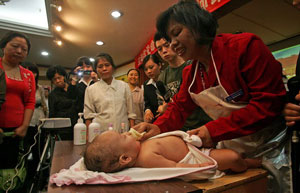Opinion
Debate: Workers' income
(China Daily)
Updated: 2010-11-08 15:43
 |
Large Medium Small |
Hua Sheng
Read facts before reaching conclusion
The proportion of Chinese workers' income in the country's GDP, according to official data, has been declining over the years. Hence, the general perception is that their salary should be increased during the 12th Five-Year Plan (2011-2015). In fact, the government has decided to do so. There is nothing wrong with that.
But according to our research, the relative figures of declining workers' income are based on a misreading of statistical specifications, and thus the need to be adjusted.
According to figures from various sources, such as the sample survey conducted by the National Bureau of Statistics (NBS) and the entity part in the flow-of-funds statements of the national economic survey, the proportion of workers' wages in primary and secondary distribution has been decreasing, and it dropped dramatically in 2004.
But the drastic drop in 2004 was the result of the significant adjustment in statistical specifications carried out by the NBS in reference to the national economic survey figures of that year. The income of non-agricultural self-employed people, which used to be counted as "workers' pay" was placed in the "earned surplus" category. It is this missing part that caused the dramatic drop in the total amount of workers' wages in 2004. And it is this missing part that has led to its assumed continuous decline since then.
To make the figures more coherent after the adjustment, the NBS regulated workers' wages according to the historical database. As a result, the GDP figure increased. With a smaller numerator and a larger denominator, the ratio of workers' income in GDP dropped substantially from about 60 percent to just more than 49 percent.
Given the figures after the adjustment, the ratio of Chinese workers' income in GDP is lower than that of its counterparts in most developed countries - but higher than that in many developing countries.
According to the United Nations' SNA93 specifications, the income of non-agricultural self-employed people as well as farmers should be excluded from workers' income. But the NBS excluded only non-agricultural self-employed people's income, and not farmers', from workers' total income. If the income of farmers were excluded, the ratio would have dropped by 5 percentage points to just more than 44 percent. This means the ratio of workers' income in GDP was just above 44 percent even in 2004. If that were the case, the proportion of their income has not dropped significantly since then.
The real ratio of workers' income in China's GDP is 6 to 10 percent less than that in developed countries. But this difference is understandable because of the advantages Western goods and services enjoy in brands and patents.
The tertiary industries in Western countries are highly developed and account for more than 70 percent of their GDP because of the high value added products they make. China, on the other hand, is still in the middle stages of industrialization, with its industrial value added products accounting for just half of its GDP and its less developed tertiary industry, a mere 40 percent. This has restricted the share of workers' income in primary distribution from increasing.
The ratios of workers' income in the GDPs of Japan and South Korea, and Taiwan rose gradually with industrialization and urbanization. But despite that, the ratio of workers' income in China is close to that in South Korea, although the latter's per capita GDP is much higher. And this ratio fluctuates.
Therefore, it's not true that the higher the workers' ratio in GDP, the better the social scenario would be. The ratio depends to a large extent on the stage of an economy's growth and improvement in labor productivity. If China does not improve the share of its value added products and services in the global industrial chain, the loss it would suffer would outweigh the gains of increasing the ratio forcibly.
But our studies show that the ratio of farmers' income in GDP has indeed declined. In fact, it has dropped by 10 percentage points since the 1990s. So, it is more urgent that the government focus its attention on increasing the income of people engaged in farming, fishing, forestry and animal husbandry.
The ratio of workers' income in GDP depends more on the stage of a country's economic development. It is important that we do not misread or misjudge it. In the same vein, there is no need to narrow the gap between the rich and poor, if it has to be done artificially. If indeed the Chinese government decides to narrow the wealth gap, the measures it will have to take will be a lot more painful than any of the actions people have suggested.
The author is a professor of economics at Beijing Normal University.




